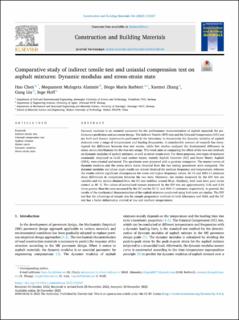| dc.contributor.author | Chen, Hao | |
| dc.contributor.author | Alamnie, Mequanent Mulugeta | |
| dc.contributor.author | Barbieri, Diego Maria | |
| dc.contributor.author | Zhang, Xuemei | |
| dc.contributor.author | Liu, Gang | |
| dc.contributor.author | Hoff, Inge | |
| dc.date.accessioned | 2023-03-29T12:27:31Z | |
| dc.date.available | 2023-03-29T12:27:31Z | |
| dc.date.created | 2022-12-26T19:01:29Z | |
| dc.date.issued | 2022 | |
| dc.identifier.citation | Chen, H., Alamnie, M. M., Barbieri, D. M., Zhang, X., Liu, G., & Hoff, I. (2023). Comparative study of indirect tensile test and uniaxial compression test on asphalt mixtures: Dynamic modulus and stress-strain state. Construction and Building Materials, 366, 130187. | en_US |
| dc.identifier.issn | 0950-0618 | |
| dc.identifier.uri | https://hdl.handle.net/11250/3060928 | |
| dc.description.abstract | Dynamic modulus is an essential parameter for the performance characterisation of asphalt materials for performance prediction and pavement design. The Indirect Tensile (IDT) test and the Uniaxial Compression (UC) test are both well-known experiments performed in the laboratory to characterise the dynamic modulus of asphalt mixtures over a range of temperatures and loading frequencies. A considerable amount of research has investigated the difference between two test modes, while few studies analysed the fundamental difference in stress–strain distributions for the two test setups. This work aims at comparing the effect of the two test methods on dynamic modulus of asphalt mixtures, as well as stress–strain state. For these purposes, two types of mixtures commonly employed to build road surface layers, namely Asphalt Concrete (AC) and Stone Mastic Asphalt (SMA), were created and tested. The specimens were prepared with a gyratory compactor. The master curves of dynamic modulus and the stress–strain states obtained from the two testing procedures were compared. The dynamic modulus and phase angle results are almost identical for medium frequency and temperature, whereas the results exhibit significant discrepancies for lower and higher frequency values. AC 11 and SMA 11 mixtures show differences in comparison between the two tests. Moreover, the strains measured by the IDT test are variable and the strains obtained from the UC test stabilise around 40 με. Similarly, both tests have poor strain control at 40 °C. The values of normalised stresses measured by the IDT test are approximately 3.26 and 2.34 times greater than the ones measured by the UC test for AC 11 and SMA 11 mixtures, respectively. In general, the results of the mechanical characterisation of the asphalt mixtures conducted using both tests are similar. The IDT test has the advantage of sample size for sample preparation methods in both laboratory and field, and the UC test has a better deformation control at low and medium temperatures. | en_US |
| dc.language.iso | eng | en_US |
| dc.publisher | Elsevier | en_US |
| dc.rights | Navngivelse 4.0 Internasjonal | * |
| dc.rights.uri | http://creativecommons.org/licenses/by/4.0/deed.no | * |
| dc.title | Comparative study of indirect tensile test and uniaxial compression test on asphalt mixtures: Dynamic modulus and stress-strain state | en_US |
| dc.type | Peer reviewed | en_US |
| dc.type | Journal article | en_US |
| dc.description.version | publishedVersion | en_US |
| dc.rights.holder | The authors | en_US |
| dc.subject.nsi | VDP::Teknologi: 500 | en_US |
| dc.source.pagenumber | 16 | en_US |
| dc.source.volume | 366 | en_US |
| dc.source.journal | Construction and Building Materials | en_US |
| dc.identifier.doi | 10.1016/j.conbuildmat.2022.130187 | |
| dc.identifier.cristin | 2097451 | |
| cristin.ispublished | true | |
| cristin.fulltext | original | |
| cristin.qualitycode | 2 | |

